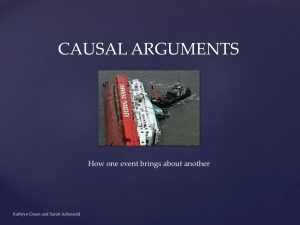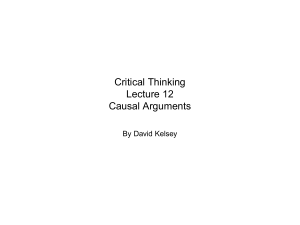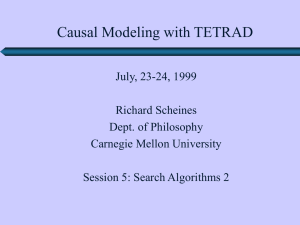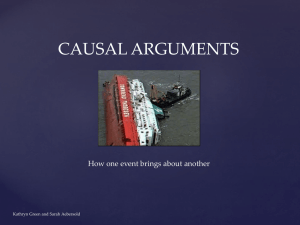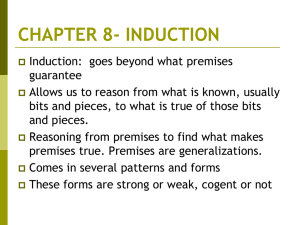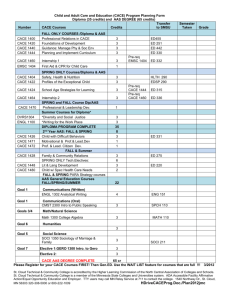Introduction to causal inference and the analysis of treatment effects
advertisement
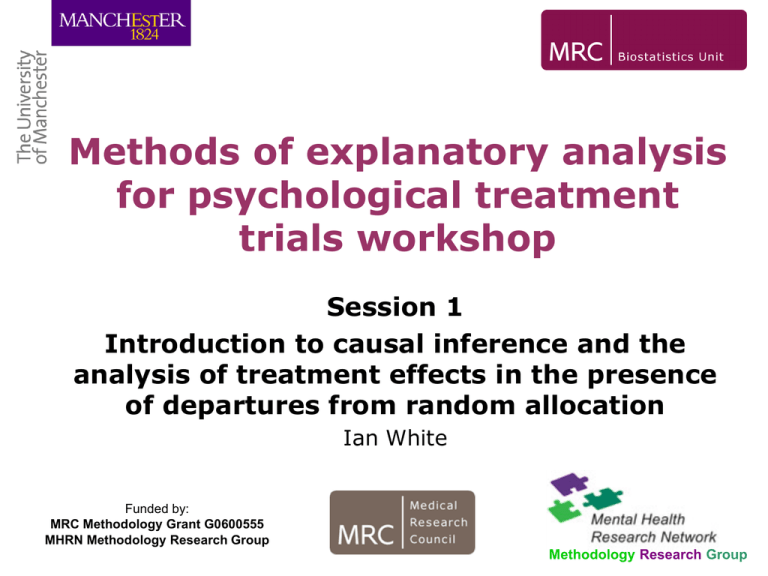
Methods of explanatory analysis
for psychological treatment
trials workshop
Session 1
Introduction to causal inference and the
analysis of treatment effects in the presence
of departures from random allocation
Ian White
Funded by:
MRC Methodology Grant G0600555
MHRN Methodology Research Group
Methodology Research Group
Plan of session 1
1. Describe departures from random allocation
2. Intention-to-treat analysis, per-protocol analysis and
their limitations
3. What do we want to estimate?
4. Estimation methods: principal stratification
5. Instrumental variables
6. Structural mean model
7. Extensions: complex departures, missing data,
covariates
8. Small group discussion
Illustrated with data from the ODIN and SoCRATES trials
2
Parallel-group trial
Recruit
Randomise
Standard
treatment (S)
Experimental
treatment (E)
Get 0
Get X
???
Get E
Get S
?
Measure outcome
Switches
??
Get E
??
Get S
?
Get X
Get 0
???
Measure outcome
Changes to non-trial treatment
3
Aim of session 1
• Infer causal effect of treatment in the presence of
departures from randomised intervention
– Better term than “non-compliance”: includes both
non-adherence and changes in prescribed treatment
• Types of departure:
– Switches to other trial treatment or changes to nontrial (or no) treatment
– Yes / no or quantitative (e.g. attend some sessions)
– Constant or time-dependent
• We’ll start by considering the simplest case: all-ornothing switches to the other trial treatment
• The methods introduced here will be used in later
sessions
4
Plan of session 1
1. Describe departures from random allocation
2. Intention-to-treat analysis, per-protocol analysis
and their limitations
3. What do we want to estimate?
4. Estimation methods: principal stratification
5. Instrumental variables
6. Structural mean model
7. Extensions: complex departures, missing data,
covariates
8. Small group discussion
All illustrated with data from the ODIN trial
5
Intention-To-Treat (ITT) Principle
http://www.consort-statement.org/ glossary:
• “A strategy for analyzing data in which all participants
are included in the group to which they were assigned,
whether or not they completed the intervention given to
the group.
• “Intention-to-treat analysis prevents bias caused by the
loss of participants, which may disrupt the baseline
equivalence established by random assignment and
which may reflect non-adherence to the protocol.”
• Now the standard analysis – and rightly so
6
Intention-to-treat analysis
• Compare groups as randomised, ignoring any
departures
• Answers an important pragmatic question
– e.g. the public health impact of prescribing E
• Disadvantage: this may be the wrong question!
– may want to explore public health impact of
prescribing E outside the trial, when compliance
might be less
» alternative pragmatic question
– may want to know the effect of receiving E
» explanatory question
7
Disadvantage of ITT
• “Doctor doctor, will psychotherapy cure my depression?”
• “I don’t know, but I expect prescribing psychotherapy to
reduce your BDI score by 5 units …
– on average …
– that’s on average over whether you attend or not”
• Clearly, judgements about whether a patient is likely to
attend, take a drug, etc., should be a part of prescribing
• But we often need to know effects of attendance, the
drug, etc. in themselves
8
Per-protocol (PP) analysis
• Alternative to ITT
• Exclude any data collected after a departure from
randomised treatment
– requires careful pre-definition: what will be counted
as departures?
• Idea is to exclude data that doesn’t allow for the full
effect of treatment
• However, PP implicitly assumes that individuals with
different treatment experience are comparable
– rarely true
– in practice there can be substantial selection bias
9
Alternative to ITT and PP
• We adopt a “causal modelling” approach that carefully
considers what we want to estimate and what
assumptions are needed to do so
• Estimation will avoid assumptions of comparability
between groups as treated
– will instead be based on comparisons of randomised
groups
10
Plan of session 1
1. Describe departures from random allocation
2. Intention-to-treat analysis, per-protocol analysis and
their limitations
3. What do we want to estimate?
4. Estimation methods: principal stratification
5. Instrumental variables
6. Structural mean model
7. Extensions: complex departures, missing data,
covariates
8. Small group discussion
All illustrated with data from the ODIN trial
11
What do we want to estimate?
• The effect of the intervention, if everyone had received
their randomised intervention?
– “average causal effect”, ACE
– “average treatment effect”, ATE
– conceptual difficulties:
» how could we make them receive their
randomised intervention?
» would this be ethical?
» would it have other consequences?
– technical difficulties:
» turns out to be unidentified (unestimable) without
further strong assumptions
12
What do we want to estimate? (2)
Alternatives to the average causal effect:
• “Average treatment effect in the treated”, ATT
• “Complier-average causal effect”, CACE
– to be defined below
• Note how we separate what we want to estimate from
analysis methods
13
Counterfactuals
• Consider a trial of intervention E vs. control S
• Define “counterfactual” or “potential” outcomes:
– Yi(1) = outcome for individual i if they received
intervention
– Yi(0) = outcome for individual i if they received
control
– We can only observe one of these!
• Intervention effect for individual i is Di = Yi(1) - Yi(0)
• Then average causal effect of intervention is E[Di]
– the average difference between outcome with
intervention and outcome with control
14
Estimation with perfect compliance
• With perfect compliance, we observe
– Yi(1) in everyone in the intervention arm
– Yi(0) in everyone in the control arm
• Randomisation means that mean outcome with
intervention can be estimated by mean outcome of
those who got intervention
E[Yi | R=E]
– E[Yi | R=S]
= E[Yi(1) | R=E] – E[Yi(0) | R=S]
= E[Yi(1)]
– E[Yi(0)]
= E[Di]
– Not true with imperfect compliance!
• So ITT estimates the average causal effect of
intervention
15
Estimation with imperfect compliance
• Assume “all-or-nothing” compliance
– everyone gets either intervention or control
• In the intervention arm, we observe
– Yi(1) in compliers
– Yi(0) in non-compliers
• In the control arm, we observe
– Yi(0) in compliers
– Yi(1) in “contaminators”
• Need assumptions to estimate the average causal effect
of intervention
• A very simple assumption is
– Yi(1) - Yi(0) = b
– b is the (average) causal effect of intervention
16
Estimation with imperfect compliance
(2)
• Continuing with “causal model” Yi(1) - Yi(0) = b
– can be written as Yi = Yi(0) + b Di
– Di = 1 if intervention was received, else 0
• Implies that expected difference in outcome (between
randomised groups) = causal effect of intervention x
expected difference in intervention receipt
– E[Yi|R=E] – E[Yi|R=S] = b {E[Di|R=E] – E[Di|R=S]}
• This gives the simplest causal estimator:
• causal effect of intervention = expected difference in
outcome / expected difference in intervention receipt
17
But …
• Angrist, Imbens and Rubin (1996) took a different
perspective and showed that this estimator isn’t what it
seems
• To see this, consider “counterfactual treatments”:
– DiE = treatment if randomised to intervention
– DiS = treatment if randomised to control
– both are 0/1 (received standard / intervention)
• Implies 4 types of person (“compliance-types”):
– DiE=1, DiS=1: always-takers
– DiE=1, DiS=0: compliers
– DiE=0, DiS=0: never-takers
– DiE=0, DiS=1: defiers – assumed absent
18
Introducing the complier-average
causal effect
Outcome if randomised to
intervention
control
Always-taker
Yi(1)
Yi(1)
Complier
Yi(1)
Yi(0)
Never-taker
Yi(0)
Yi(0)
• The observed data tell us nothing about the causal
effects of treatment in always-takers and never-takers
• In fact, our simple estimator estimates the “complieraverage causal effect” (CACE) = E[Di| DiE=1, DiS=0]
• This is all we can hope to estimate in RCTs!
19
Problems with the CACE
• We don’t know who is a “complier”
• In practice, we may want to know what will be
observed
– if compliance is worse than in the trial (e.g. if rolled
out in clinical practice)
– if compliance is better than in the trial (e.g. because
intervention is well publicised / marketed)
This means we want to know the average causal effect
in a different subgroup. We might assume this is the
CACE – but it is an assumption
20
Summary of things we can estimate
•
•
•
•
•
ITT:
PP:
ACE/ATE:
ATT:E[Y(1)
CACE:
E[Y|R=E] – E[Y|R=S]
E[Y|R=E, DE=1] – E[Y|R=S, DS=0]
E[Y(1) – Y(0)]
– Y(0) | DE=1]
E[Y(1) – Y(0) | DE=1, DS=0]
We are going to explore ways to estimate the CACE
21
Plan of session 1
1. Describe departures from random allocation
2. Intention-to-treat analysis, per-protocol analysis and
their limitations
3. What do we want to estimate?
4. Estimation methods: principal stratification
5. Instrumental variables
6. Structural mean model
7. Extensions: complex departures, missing data,
covariates
8. Small group discussion
All illustrated with data from the ODIN trial
22
Principal stratification
• An idea of Frangakis and Rubin (1999), generalising the
simple compliance-types above
• Again, let
– DiE = treatment if randomised to intervention
– DiS = treatment if randomised to control
where both could be complex (e.g. numbers of
sessions of psychotherapy)
• Principal strata are the levels of the pair (DiE, DiS)
23
Using principal stratification
• We should model outcomes conditional on principal
strata
– typically allow a different mean for each principal
stratum – avoids assuming they are comparable
– allow differences between randomised groups within
principal strata
– these parameters have a causal meaning
• Of course this may not be easy, since for every
individual we only know one of (DiE, DiS) so we don’t
know their principal stratum
24
Example: ODIN trial
• Trial of 2 psychological interventions to reduce
depression (Dowrick et al, 2000)
• Randomised individuals:
– 236 to the psychological interventions (E)
– 128 to treatment as usual (S)
• Outcome: Beck Depression Inventory (BDI) at 6 months
– recorded on 317 randomised individuals
ITT results
Unadjusted
Adjusted for
baseline BDI
Mean (SD)
Difference in BDI6
(std error)
E (n=177) S (n=140)
13.29
(9.85)
15.16
(10.42)
-1.87 (1.14)
-2.28 (1.02)
25
ODIN trial: compliance
• Of 236 individuals randomised to psychological
interventions, 128 (54%) attended in full
– others refused, did not attend or discontinued
• Psychological interventions weren’t available to the
control arm (no “contaminators”) so DS=0 for all
• Only 2 principal strata:
– would attend if randomised to intervention
» DE=1, “compliers”
– would not attend if randomised to intervention
» DE=0, “never-takers”
26
Exclusion restriction
• Key assumption used to identify the CACE
• In individuals for whom randomisation has no effect on
treatment (e.g. in never-takers and always-takers),
randomisation has no effect on outcome
• Often reasonable: e.g. in a double-blind drug trial, not
taking active drug is the same as not taking placebo
• But not always reasonable: e.g. not attending
counselling despite being invited could be different from
not attending because uninvited
– “I wouldn’t have gone, but I’d like to have been
invited”
27
Exclusion restriction in ODIN
• In ODIN, the exclusion restriction means that
randomisation has no effect on outcomes in those who
would not attend if randomised to psychological
intervention
• But recall that we included those who discontinued as
“non-attenders”
– their partial attendance is very likely to have had
some effect on them
– the exclusion restriction would be more plausible if
we defined compliance as any attendance
– we’ll return to this later
28
CACE analysis (complete cases)
# participants
mean BDI
Compliers
Never-takers
All
Therapy (E)
118
13.32
59
13.22
177
13.29
Control (S)
?
?
?
?
140
15.16
29
CACE analysis (2)
# participants
mean BDI
Compliers
Never-takers
All
118
13.32
59
13.22
177
13.29
Therapy (E)
complier-average
causal effect (CACE)
Control (S)
93.3
16.13
CACE = 13.32 – 16.13 = -2.81
(cf ITT = 13.29 – 15.16 = -1.87)
randomisation balance
(59*140/177)
46.7
13.22
exclusion
restriction
140
15.16
Note: 66.7%
compliance (118/177) 30
ITT / 0.667 = CACE
CACE vs. PP
# participants
mean BDI
Therapy (E)
Compliers
Never-takers
All
118
13.32
59
13.22
177
13.29
CACE
Control (S)
93.3
16.13
PP
equal
equal
46.7
13.22
140
15.16
CACE is based on the “exclusion restriction” assumption
Per-protocol analysis estimates the CACE under the
“random non-compliance” assumption
31
Plan of session 1
1. Describe departures from random allocation
2. Intention-to-treat analysis, per-protocol analysis and
their limitations
3. What do we want to estimate?
4. Estimation methods: principal stratification
5. Instrumental variables
6. Structural mean model
7. Extensions: complex departures, missing data,
covariates
8. Small group discussion
All illustrated with data from the ODIN trial
32
Instrumental variables (IV)
• Popular in econometrics
• Model:
– Model of interest: Yi = a + b Di + ei
– Error ei may be correlated with Di (“endogenous”)
– Example in econometrics: D is years of education, Y
is adult wage, e includes unobserved confounders
• We can’t estimate b by ordinary linear regression
• Instead, we assume error ei is independent of an 3rd
instrumental variable Ri
– i.e. Ri only affects outcome through its effect on Di
– or: randomisation only affects outcome through its
effect on treatment actually received
33
IV estimation
• Estimation by “two-stage least squares”: model implies
– E[Yi | Ri] = a + b E[Di | Ri]
– so first regress Di on Ri to get E[Di | Ri]
– then regress Yi on E[Di | Ri]
– NB standard errors not quite correct by this method:
general IV uses different standard errors
• More generally, we use an estimating equation based on
Si Ri (Yi – a – b Di ) = 0
34
Instrumental variables for ODIN
. ivreg bdi6 (treata=z)
Instrumental variables (2SLS) regression
Source |
SS
df
MS
-------------+-----------------------------Model | -58.5115086
1 -58.5115086
Residual | 32532.4232
315 103.277534
-------------+-----------------------------Total | 32473.9117
316 102.765543
Number of obs
F( 1,
315)
Prob > F
R-squared
Adj R-squared
Root MSE
=
=
=
=
=
=
317
2.64
0.1049
.
.
10.163
-----------------------------------------------------------------------------bdi6 |
Coef.
Std. Err.
t
P>|t|
[95% Conf. Interval]
-------------+---------------------------------------------------------------treata | -2.803511
1.724143
-1.63
0.105
-6.195802
.5887801
_cons |
15.15714
.8588927
17.65
0.000
13.46725
16.84703
-----------------------------------------------------------------------------Instrumented: treata
Instruments:
z
Same estimate as before!
35
------------------------------------------------------------------------------
Easy to extend to include covariates
. ivreg bdi6 (treata=z) bdi0
Instrumental variables (2SLS) regression
Source |
SS
df
MS
-------------+-----------------------------Model | 6808.64828
2 3404.32414
Residual | 25665.2634
314 81.7365076
-------------+-----------------------------Total | 32473.9117
316 102.765543
Number of obs
F( 2,
314)
Prob > F
R-squared
Adj R-squared
Root MSE
=
=
=
=
=
=
317
43.26
0.0000
0.2097
0.2046
9.0408
-----------------------------------------------------------------------------bdi6 |
Coef.
Std. Err.
t
P>|t|
[95% Conf. Interval]
-------------+---------------------------------------------------------------treata | -3.428509
1.539881
-2.23
0.027
-6.458298
-.3987196
bdi0 |
.5813933
.0630405
9.22
0.000
.4573581
.7054285
_cons |
2.395561
1.546673
1.55
0.122
-.6475924
5.438714
-----------------------------------------------------------------------------Instrumented: treata
36
Usual gain in precision
Instruments:
bdi0 z
------------------------------------------------------------------------------
Plan of session 1
1. Describe departures from random allocation
2. Intention-to-treat analysis, per-protocol analysis and
their limitations
3. What do we want to estimate?
4. Estimation methods: principal stratification
5. Instrumental variables
6. Structural mean model
7. Extensions: complex departures, missing data,
covariates
8. Small group discussion
All illustrated with data from the ODIN trial
37
Structural mean model (SMM)
• Extends our simple model Yi(1) - Yi(0) = b
• SMM is E[YiE - YiC | DiE, DiC, X] = b Di*
– where Di* is a summary of treatment thought to
have a causal effect, e.g.:
» Di* = DiE – DiC: causal effect of treatment is
proportional to amount of treatment
» Di* = (DiE – DiC , Xi(DiE – DiC)): and X is an effect
modifier
• Goetghebeur and Lapp, 1997 (assumed DiC=0)
• Estimation is equivalent to instrumental variables with R
and R*X as instruments
– in other words, we also assume that X does not
modify the causal effect of treatment
38
Summary for binary compliance
• The principal stratification approach divides individuals
into always-takers, compliers and never-takers
• We can then identify the complier-average causal effect,
provided we make the exclusion restriction assumption
• This works for binary or continuous outcomes
• Instrumental variables and structural mean models
approaches lead to the same estimates for continuous
outcomes
• For binary outcomes, instrumental variables are
problematic, and generalised structural mean models
are needed (Vansteelandt and Goetghebeur, 2003)
39
Plan of session 1
1. Describe departures from random allocation
2. Intention-to-treat analysis, per-protocol analysis and
their limitations
3. What do we want to estimate?
4. Estimation methods: principal stratification
5. Instrumental variables
6. Structural mean model
7. Extensions: complex departures, missing data,
covariates
8. Small group discussion
All illustrated with data from the ODIN trial
40
Example with missing outcome data
• Our IV analyses of ODIN used complete cases only
• This is a bad idea
• Follow-up rates were worse in non-attenders (55%)
than in attenders (92%)
• So we modify the previous analysis
• We will now assume the data are “missing at random”
given randomised group and attendance
– e.g. among non-attenders, there is no difference on
average between non-responders and responders
41
CACE analysis under MAR
Mean BDI
participants
Compliers
118 128
13.32
Therapy (E)
complier-average
causal effect (CACE)
Control (S)
93.3 103.6
16.13
16.80
Never-takers
59 108
13.22
All
177 236
13.29
randomisation balance
(108*191/236)
46.7 87.4
13.22
exclusion
restriction
CACE (MAR) = 13.32 – 16.80 = -3.48
cf CACE (CC) = 13.32 – 16.13 = -2.81
140 191
15.16
42
A more general approach
• We can allow for missing data by using inverse
probability weights
• Suppose a certain group of individuals has only 50%
chance of responding
– give each responder in that group a weight of 2
– accounts for their non-responding fellows
• In ODIN, we will consider the baseline-adjusted analysis
• We will construct weights depending on baseline BDI,
randomised group and attendance
43
Constructing the weights
. logistic resp6 z treata bdi0
Logistic regression
Log likelihood = -218.70364
Number of obs
LR chi2(3)
Prob > chi2
Pseudo R2
=
=
=
=
427
49.84
0.0000
0.1023
-----------------------------------------------------------------------------resp6 | Odds Ratio
Std. Err.
z
P>|z|
[95% Conf. Interval]
-------------+---------------------------------------------------------------z |
.4327186
.1102412
-3.29
0.001
.2626333
.7129535
treata |
10.1753
3.909568
6.04
0.000
4.791789
21.60713
bdi0 |
.9750455
.0136551
-1.80
0.071
.9486461
1.00218
-----------------------------------------------------------------------------. predict presp
(option pr assumed; Pr(resp6))
. gen wt=1/presp
44
2.5
Examining the weights
wt
2
therapy, non-compliers
1.5
control
1
therapy, compliers
10
20
30
bdi@baseline
40
50
45
Weighted IV analysis
. ivreg bdi6 (treata=z) bdi0 [pw=wt]
(sum of wgt is
4.2710e+02)
Instrumental variables (2SLS) regression
Number of obs
F( 2,
314)
Prob > F
R-squared
Root MSE
=
=
=
=
=
317
37.28
0.0000
0.2183
9.0521
-----------------------------------------------------------------------------|
Robust
bdi6 |
Coef.
Std. Err.
t
P>|t|
[95% Conf. Interval]
-------------+---------------------------------------------------------------treata | -3.953868
1.944846
-2.03
0.043
-7.780444
-.1272916
bdi0 |
.5810663
.0680343
8.54
0.000
.4472056
.714927
_cons |
2.37602
1.554941
1.53
0.128
-.6834003
5.435441
-----------------------------------------------------------------------------Instrumented: treata
Instruments:
bdi0 z
46
------------------------------------------------------------------------------
Back to the exclusion restriction
• Recall that partial attenders were included as noncompliers
• If instead we include them as compliers, the exclusion
restriction is much more plausible
• The estimated causal effect is smaller because it is an
average over a wider group that includes partial
compliers
Definition of complier
Causal effect (95% CI)
Full attendance
-3.95 (-7.78 to -0.13)
Any attendance
-3.19 (-6.17 to -0.21)
47
Summary of ODIN results
Analysis
Missing
data?
ITT
CC (=MAR) n
CACE
CC
MAR
Adjusted? Complier
definition
full
Causal effect
(std. error)
-1.87 (1.14)
y
-2.28 (1.02)
n
-2.81 (1.72)
y
-3.43 (1.54)
n
-3.48 (2.15)
y
-3.95 (1.94)
any
-3.19 (1.51)
48
Example with continuous compliance:
the SoCRATES trial
• SoCRATES was a multi-centre RCT designed to evaluate
the effects of cognitive behaviour therapy (CBT) and
supportive counselling (SC) on the outcomes of an early
episode of schizophrenia.
• 201 participants were allocated to one of three groups:
– Control: Treatment as Usual (TAU)
– Treatment: TAU plus psychological intervention,
either CBT + TAU or SC + TAU
– The two treatment groups are combined in our
analyses
• Outcome: psychotic symptoms score (PANSS) at 18
months
49
SoCRATES: ITT results
ITT results
Unadjusted
Adjusted for
baseline
PANSS and
centre
Mean (SD)
E (n=84)
S (n=69)
61.1
(20.0)
66.3
(18.2)
Difference in 18m
PANSS (95% CI)
-5.2
(-11.3 to +1.0)
-6.7
(-11.7 to -1.6)
50
SoCRATES: compliance
• We have a record of the number of sessions attended
– ranges from 2 to 29 in the intervention group
– 0 for all in the control group
• We could dichotomise
– e.g. split at the median (17)
– attending <17 sessions is “non-compliance”
– BUT the exclusion restriction is implausible
• Instead, we keep number of sessions as continuous
51
Model for continuous compliance
• Structural mean model: Yi(1) - Yi(0) = b Di(1)
• The causal effect of d sessions is proportional to the
number of sessions
– 20 sessions are twice as good as 10 sessions
• This is an assumption that you have to believe
• Q: is this assumption wrong if individuals continue with
sessions until they feel they have achieved an adequate
benefit?
• Estimation can be done by instrumental variables just
as before
52
IV model in SoCRATES
. ivregress 2sls pant18 (sessions=rg) i.centre pantot [pw=1/presp], small
(sum of wgt is
2.0101e+02)
NB: I’ve used Stata 11 here
-----------------------------------------------------------------------------|
Robust
pant18 |
Coef.
Std. Err.
t
P>|t|
[95% Conf. Interval]
-------------+---------------------------------------------------------------sessions | -.4243381
.1632735
-2.60
0.010
-.7469866
-.1016897
|
centre |
2 |
5.927803
4.013788
1.48
0.142
-2.003934
13.85954
3 | -11.32247
2.523946
-4.49
0.000
-16.3101
-6.334842
|
pantot |
.4236632
.091294
4.64
0.000
.243255
.6040714
_cons |
30.27006
7.72171
3.92
0.000
15.01101
45.5291
-----------------------------------------------------------------------------Instrumented: sessions
Instruments:
2.centre 3.centre pantot rgroup
Each extra session reduces PANSS by 0.4 points
53
Summary for continuous compliance
• There are too many principal strata for the principal
stratification approach to work
• Instrumental variables and structural mean models
approaches work for continuous outcomes
54
Plan of session 1
1. Describe departures from random allocation
2. Intention-to-treat analysis, per-protocol analysis and
their limitations
3. What do we want to estimate?
4. Estimation methods: principal stratification
5. Instrumental variables
6. Structural mean model
7. Extensions: complex departures, missing data,
covariates
8. Small group discussion
All illustrated with data from the ODIN trial
55
Practical session
• Please work in small groups.
• We’ll consider the “Down your drink” (DYD) trial
– internet users seeking help with their drinking were
randomised to a new interactive website or control.
– the intervention group’s use of the new website is
measured by the number of page hits. The mean
was 60 hits over a 3-month period.
– outcome: weekly alcohol consumption at 3 months
• I will list some possible analyses of this trial, all aiming
to estimate the causal effect of treatment. In each case,
please:
– identify the underlying assumption
– decide how plausible you think that assumption is.
56
Analyses to consider (1)
1. Regarding those who hit less than 60 pages as “noncompliers”:
a) A per-protocol analysis: intervention group
compliers compared with the control group
b) A CACE analysis: intervention group compliers
compared with those members of the control group
who would have complied if they had been
randomised to intervention
2. The same, but regarding those who hit less than 10
pages as “non-compliers”
3. A structural mean model analysis, modelling the causal
effect of the intervention as proportional to the number
of pages hit
57
Analyses to consider (2)
The control group had access to a different web site, and
averaged 30 page hits.
• A per-protocol analysis: intervention group with >60
page hits compared with the control group with >30
page hits
• A SMM analysis modelling the causal effect of each
intervention as proportional to the number of pages hit
(with different parameters)
• Do you have any other suggestions for the analysis?
58
References
• Dowrick C, Dunn G, et al. Problem solving treatment
and group psychoeducation for depression: multicentre
randomised controlled trial. BMJ 2000; 321: 1450–4.
• Goetghebeur E, Lapp K. The effect of treatment
compliance in a placebo-controlled trial: Regression with
unpaired data. JRSS(C) 1997; 46: 351–364.
• Angrist JD, Imbens GW, Rubin DB. Identification of
causal effects using instrumental variables. JASA 1996;
91: 444–455.
59
Suggested further reading
• Dunn G et al. Estimating psychological treatment effects
from a randomised controlled trial with both non-compliance
and loss to follow-up. British Journal of Psychiatry 2003;
183: 323–331.
– simple CACE methods
• Maracy M, Dunn G. Estimating dose-response effects in
psychological treatment trials: the role of instrumental
variables. SMiMR 2008.
– IV methods
• White IR. Uses and limitations of randomization-based
efficacy estimators. SMiMR 2005; 14: 327–347.
– overview of ideas
• Fischer-Lapp K, Goetghebeur E. Practical properties of some
structural mean analyses of the effect of compliance in
randomized trials. Controlled Clinical Trials 1999; 20: 531–60
546.




